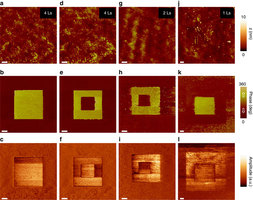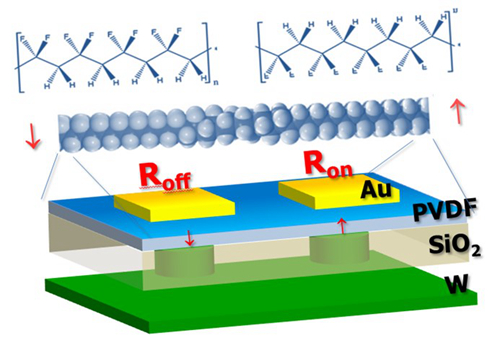

Organic electronics is emerging for large-area applications such as photovoltaic cells, rollable displays or electronic paper. Its future development and integration will require a simple, low-power organic memory that can be written, erased and read out electrically. Here researchers at the Shanghai Institute of Technical Physics,Chinese Academy of Sciences (CAS) demonstrate a non-volatile memory in which the ferroelectric polarization state of an organic tunnel barrier encodes the stored information and sets the readout tunnel current. They use high-sensitivity piezoresponse force microscopy to show that films as thin as one or two layers of ferroelectric poly (vinylidene fluoride) remain switchable with low voltages. Submicron junctions based on these films display tunnel electroresistance reaching 1,000 percent at room temperature that is driven by ferroelectric switching and explained by electrostatic effects in a direct tunneling regime. Their findings provide a path to develop low-cost, large-scale arrays of organic ferroelectric tunnel junctions on silicon or flexible substrates.
In emerging ferroelectric tunnel junctions (FTJs), switching the polarization of an ultrathin ferroelectric barrier sandwiched between two electrodes modulates the junction resistance, giving rise to giant tunnel electroresistance (TER). This simple non-destructive resistive readout of the ferroelectric information could alleviate scalability issues encountered with the destructive capacitive readout in conventional ferroelectric random access memories. In addition, FTJs open a new route for the nanoscale control of the spintronic response when using ferromagnetic metals as electrodes. Although experimental evidence suggests that TER is undoubtedly associated with ferroelectric polarization switching, there are still some fundamental issues to be addressed. Indeed, large TER in oxide-based tunnel junctions cannot be interpreted by simple electrostatic models involving partial screening of polarization charges at the interfaces, but necessitates complex descriptions involving interfacial dielectric layers or doped-semiconducting layer. Moreover, almost all the experimentally reported FTJs are using ferroelectric barriers made of oxide perovskite thin films. To maintain ferroelectricity in nanometre-thick oxide films, sophisticated experimental approaches such as strain engineering and careful control of epitaxial growth are generally required, which inevitably results in a complex fabrication process, not to mention the limitation of large-area production of such inorganic FTJs.

Figure 1
En route towards more processable FTJs, organic ferroelectric materials have also been considered as tunnel barriers. Organic ferroelectrics could open up the practical applications of FTJs to silicon technology, large-area applications or flexible electronics. In addition, organic FTJs may also exhibit different electronic transport properties from their inorganic counterparts because of the weak Van der Waals interfacial bonding. Recently, organic FTJs were reported using vinylidene fluoride (VDF) oligomer as a ferroelectric barrier. While the results are encouraging with a TER of ~500 percent using these oligomers, the homogeneity of the current is questionable considering the roughness (4 nm r.m.s. for a 7.2-nm film) and large size (0.3 mm diameter) of the junctions. Moreover, the electronic transport mechanism at play is still unidentified. Alternatively, poly (vinylidene fluoride) (PVDF) homopolymer and its copolymers with trifluoroethylene (P(VDF-TrFE)) are robust organic ferroelectrics. These copolymers are promising candidates for TER since their ferroelectric character persists down to nanometre thicknesses: conductance switching was observed at the local scale using scanning probe microscopy across 1-nm-thick P(VDF-TrFE) films and in capacitors based on 10-nm-thick P(VDF-TrFE) films. However, solid-state FTJs based on ultrathin PVDF-based films have not yet been reported and the fundamental physics of TER in organic FTJs remains to be explored.
Here, they report on the observation of a robust room-temperature TER in organic FTJs using ultrathin PVDF films (1 and 2 layers (Ls) thick, 2.2- and 4.4-nm thick, respectively). We unambiguously show that the ferroelectric switchability is sustained down to 1 layer, and reveal that charge transport across both mono- and bi-layers PVDF-based FTJs proceeds by a direct quantum-mechanical tunneling transport. They also demonstrate a stable TER reaching 1,000 percent. These results are interpreted by simple electrostatic models involving consistent physical parameters for both thicknesses.

Figure 2
In this study, pure PVDF ultrathin films are deposited layer-by-layer by the Langmuir–Blodgett (LB) technique onto silicon wafers, using gold as a bottom electrode. A major advantage of PVDF-based polymers is the ability to deposit them as thin film at room temperature on any material. Figure 1 shows the out-of-plane piezoresponse force microscopy (PFM) images of ferroelectric domains written on PVDF films of 4Ls, 2Ls and 1L. In Fig. 1b, a 5 × 5 μm2 square with upward polarization is defined by scanning the grounded atomic force microscopy (AFM) tip with a positive voltage applied to the bottom electrode. A clear 180° phase shift is observed relative to the pristine PVDF background with a homogeneous downward polarization. This ferroelectric domain pattern is supported by the PFM amplitude image (Fig. 1c) that only drops at the domain wall. This square domain with upward polarization can be switched back to its original state by scanning a 2 × 2 μm2 area with negative voltage (Fig. 1e,f). The topography of the film is not damaged during the writing process (Fig. 1a,d). This clear signature of ferroelectricity in 4Ls PVDF films is in line with polarization versus field measurements demonstrated previously. The bright (dark) PFM phase signal for polarization upward (downward) is strictly opposite to that observed in reference inorganic ferroelectrics (BiFeO3, BaTiO3, and so on) in agreement with the negative piezoresponse coefficient of PVDF. Similar ferroelectric domain patterns can be defined on 2Ls (Fig. 1g–i) and 1L (Fig. 1j–l) of PVDF, starting by writing polarization upward then downward or vice versa. This indicates that the ferroelectric polarization of 1-4Ls PVDF films is switchable, making them potentially suitable as ferroelectric tunnel barriers.
The above research result was published online in Nature Communications 7, 11502 (2016)(DOI:10.1038/ncomms11502) as “Direct tunneling through organic ferroelectrics”. First author of the article is PhD student B. B. Tian, corresponding author is Dr. J. L. Wang in collaboration with Prof. C. G. Duan from East China Normal University and Prof. V. Garcia from University of Paris-Sud, France, et al.